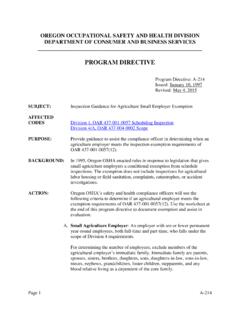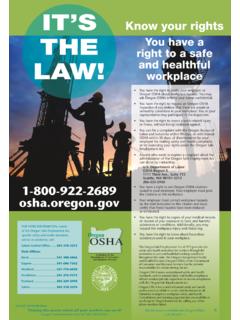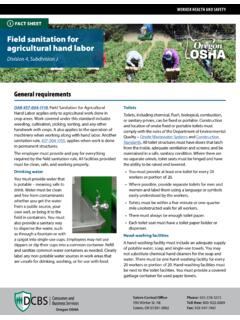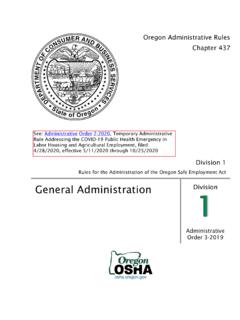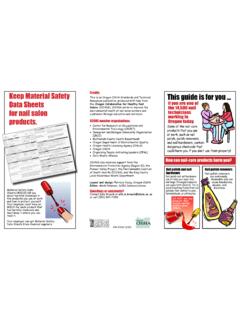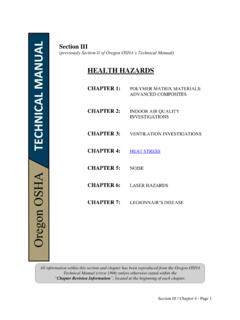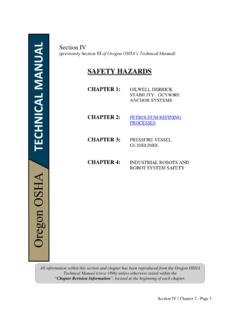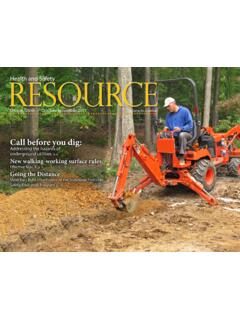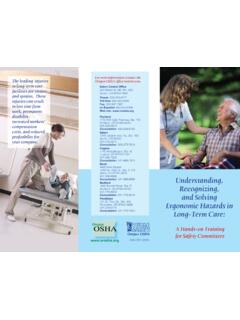Transcription of Workshop Workbook, Accident and Incident Investigation
1 Public Education Accident and Incident Investigation The Student Workshop Manual 0517-06 PUBLIC EDUCA- Accident & Incident Investigation Contact Us Oregon OSHA Public Education Mission: We provide knowledge and tools to advance self-sufficiency in workplace safety and health Consultative Services: Offers no-cost on-site assistance to help Oregon employers recognize and correct safety and health problems Enforcement: Inspects places of employment for occupational safety and health rule violations and investigates complaints and accidents Public Education: Provides free training online, workshops, and training tools Standards and Technical Resources: Develops, interprets, and provides technical advice on safety and health standards Creates booklets, pamphlets, and other materials to assist in the implementation of safety and health rules Field Offices: Portland: 503-229-5910 Salem: 503-378-3274 Eugene: 541-686-7562 Medford: 541-776-6030 Bend: 541-388-6066 Pendleton: 541-276-2353 Salem Central Office: Toll Free number in English: 800-922-2689 Toll Free number in Spanish: 800-843-8086 Website: PUBLIC EDUCA-This class is based on Oregon rules and may not be the same for all states.
2 Consult with or your state s OSHA entity for more information. Attending an Oregon OSHA Workshop or completing an online course may provide important information and guidance but may not meet all employer training requirements. The following materials should not be considered a substitute for any provisions of the Oregon Safe Employment Act or for any standards issued by Oregon OSHA. It remains the employer s responsibility to ensure all training requirements are met, including any site-specific information. For more information, contact Oregon OSHA at: 503-378-3272 (Main Office) 800-922-2689 (English toll free) 800-843-8086 (Spanish toll free) Please Note: This material, or any other material used to inform employers of compliance requirements of Oregon OSHA standards through simplification of the regulations should not be considered a substitute for any provisions of the Oregon Safe Employment Act or for any standards issued by Oregon OSHA.
3 Accident & Incident Investigation Resources PUBLIC EDUCA- Accident & Incident Investigation Table of Contents 1 The 2 The Six Step 8 1. Step 1 Securing the 9 2. Step 2 Collecting the 11 Photographing the 12 Sketching the 14 Taking Video of the 15 Document 16 Interviewing 17 3. Step 3 Developing the Sequence of 23 4. Step 4 Determining the 28 Weed out the Cause of Injuries and 29 Steps in Cause 30 Exercise: Digging up the 31 5. Step 5 Recommending 32 Engineering and Management 34 6. Step 6 Writing the 36 The Seven Elements of a Safety 37 7. Appendix Reference 38 A Average Cost for Disabling 40 B Summary of Accident Investigation 41 C Incident / Accident Analysis 43 D Incident / Accident Team 45 E Direct Causes of 48 F Sample Accident Investigators 49 G Sketching 50 H Forms of 51 I Accident Types and 52 J Sample Accident Report 53 K Accident Investigation 55 PUBLIC EDU- Accident & Incident Investigation 1 Introduction What to Expect From our WorkshopWhat to Expect From our Workshop This Workshop is one part of a blended learning program, which also includes our online Accident Investigation course.
4 To participate in our online course please visit the Oregon OSHA Public Education website: The intent of this Workshop is to help you gain the basic skills necessary to conduct an effective Accident Investigation at your workplace. We will work through the three primary tasks of the Accident investigator, discuss employer responsibilities, and learn how to write an Accident report. The three primary tasks of the Accident investigator are to: Gather useful information Analyze the facts surrounding the Accident Write the Accident report Most of the information about conducting an Accident Investigation will come directly from the Workshop as we discuss issues, answer basic questions, and complete group activities. If you have prior experience in Accident Investigation , we hope you will participate actively so others may benefit from your valuable input. Ultimately, we want you to leave this Workshop with the skills to conduct an Accident Investigation and properly complete an Accident Investigation report with confidence.
5 Experience will give you the expertise to fine-tune those skills. PUBLIC EDU- Accident & Incident Investigation 2 Accident Investigation Definitions The Basics Accident : An unexpected Incident or exposure that results in an injury or illness to an employee or property damage. Incident : Often referred to as a near miss, this is an event that could have resulted in personal harm or property damage. Lost-time injury: When an employee gets injured while carrying out a work task for the employer and unable to come in for their next shift or a longer stretch of time. Hazard: Things or objects that have the potential to harm or cause illness. Physical Exposure: An exposure which you must come into contact with to cause an injury or illness. Environmental Exposure: You must be in the general area to be affected, examples include: loud noises, chemicals fumes, Direct cause: The result of the condition and/or behavior.
6 The final event which produces an Accident . Surface cause: Hazardous conditions and unsafe employee/management behaviors that caused the Accident . Root cause: The underlying reason the surface cause exists. Personal Protective Equipment (PPE): Equipment worn to minimize exposure to a variety of hazards. An example of PPE includes gloves or hard hats. Unsafe conditions: Unsafe equipment/tools which directly cause the Accident . Unsafe actions: Harmful behaviors which contributed to the Accident , this can include gaps in safety training for staff. System weaknesses: Underlying inadequate or missing programs, plans, policies, processes, and procedures that contributed to the Accident . The BasicsThe Basics PUBLIC EDU- Accident & Incident Investigation 3 The Basics Identify the Proper Steps of Conducting an Accident Investigation The purpose of investigating accidents is to determine the following information The cause of the Accident What changes need to be implemented If this affects other work areas and locations What policies and procedures may need to be changed Actions or conditions which are unsafe but perhaps have not been recognized as being unsafe or actions which have been recognized as unsafe but which are common occurrences.
7 The responsibility for correction of unsafe work practices and conditions in the workplace lies with YOU. Where do workplace injuries come from? Unpreventable acts account about 2% of all workplace accidents Hazardous conditions account for less than 10% of all workplace accidents Hazardous practices account for the majority (approximately 98%) of all workplace accidents The unsafe practices should not be confused for blaming employees, this error rate. Unsafe practices often come down to employee training, equipment issues, work volume, time crunches, Numbers according to SAIF Loss Control Approach PUBLIC EDU- Accident & Incident Investigation 4 The Basics What s the difference between an Accident and an Incident ? _____ _____ The two key conditions must exist before an Accident occurs are: H_____ and E_____ Unpreventable acts: Only _____ % of all workplace accidents are thought to be unpreventable.
8 Heart attacks and other events that could not have been known by the employer are examples of unpreventable events. Employers may try to place most of their injuries into this category. They justify these beliefs with such comments as: "He just lifted the box wrong and strained his back. What could we do?" Unfortunately, they are excuses for not looking into the "root cause" of the injury. System failure: Safety management system failures account for at least _____ % of all workplace accidents. System failures refer to inadequate design or performance of safety programs that provide training, resources, enforcement, and supervision. No-fault Accident analysis Often Accident investigators confuse Accident Investigation with criminal Investigation , where blame is the end result. When this occurs, it obstructs the investigative process because witnesses may fear punishment. A no fault analysis looks for deeper causes within the safety management system of an organization.
9 PUBLIC EDU- Accident & Incident Investigation 5 Accidents can be a time of confusion and high emotions. Having a written Accident analysis plan which establishes what to do and when to do it can reduce decision making time. Include in your plan: Who should be notified of an Accident Who is authorized to notify outside agencies (police, fire, etc.) Who is assigned to conduct investigations (include training they will need) Who receives and acts on Investigation reports Expectation of time frames for conducting the Investigation and follow-up actions such as correction of the unsafe condition or action It is important to secure the scene, however, before securing the scene If you have to wait to secure the scene due to emergency responders providing aid, begin making initial observations. It is important to act quickly and start taking pictures or video as soon as possible as material evidence can be displaced while emergency responders tend to the injured.
10 Also, witnesses memories may change over time, impacted by conversations with other witnesses and the passing of time can make details fade. Finally, securing the scene also includes making the area safe until the root cause can be determined and safety controls have been implemented. Laying the Foundation Always make sure the scene is safe before you enter. The Basics PUBLIC EDU- Accident & Incident Investigation 6 If the Accident results in a serious injury or a fatality, you are required to report it to Oregon OSHA. The reporting timelines are as follows: Fatality/serious injury*: 8 hours Catastrophe**: 8 hours All in-patient hospitalizations: 24 hours Amputations and avulsions that include bone or cartilage loss, and the loss of an eye: 24 hours * Fatalities and some serious injuries are investigated by Oregon OSHA. ** A catastrophe consists of 2 or more fatalities or 3 or more employees hospitalized from the same event.
